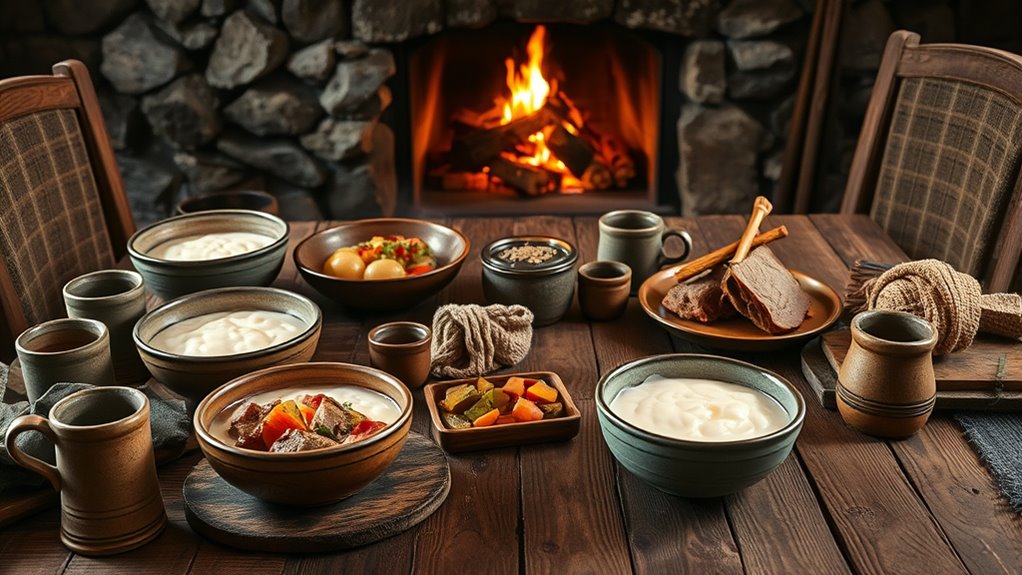Iceland’s cuisine reflects its rugged landscape and rich history, with traditional dishes like fermented shark (hákarl), smoked lamb (hangikjöt), and hearty fish stews showcasing local resources and preservation methods. Food plays a crucial role in social customs, festivals, and family gatherings, emphasizing resilience and community. Modern chefs blend these traditions with innovative techniques, creating a vibrant culinary scene. If you explore further, you’ll uncover even more about Iceland’s unique food culture and practices.
Key Takeaways
- Icelandic cuisine features traditional dishes like hákarl, hangikjöt, and plokkfiskur, reflecting resourcefulness, preservation, and cultural resilience.
- Preservation techniques such as fermenting, smoking, and drying are vital for maintaining food security and cultural heritage.
- Key ingredients include seafood, lamb, and dairy, with regional specialties like fermented shark and dense rye bread baked near hot springs.
- Modern Icelandic cuisine blends traditional ingredients with innovative techniques, emphasizing sustainability and culinary creativity.
- Food plays a central role in Iceland’s festivals and social gatherings, strengthening community bonds through shared traditional dishes.
Traditional Icelandic Dishes and Their Significance

Traditional Icelandic dishes reflect the country’s history, climate, and reliance on preserved foods. You’ll find dishes like hákarl, fermented shark, which symbolizes centuries of survival through fermentation techniques. Hangikjöt, smoked lamb, showcases the importance of sheep farming and preservation methods like smoking. Plokkfiskur, a hearty fish stew, highlights Iceland’s abundant seafood and practical use of leftovers. Rúgbrauð, dense rye bread baked near hot springs, demonstrates resourcefulness in utilizing geothermal heat. These foods aren’t just sustenance; they carry cultural significance, often served during festivals and communal gatherings. They connect Icelanders to their environment, history, and traditions, embodying resilience and resourcefulness shaped by the rugged landscape and harsh climate. Additionally, the use of natural materials like geothermal heat in baking exemplifies how Icelanders have adapted their culinary practices to their environment. These dishes remain central to Iceland’s culinary identity today.
Key Ingredients and Food Preservation Techniques

You’ll find that Iceland’s key ingredients—like fresh fish, lamb, and dairy—are central to its cuisine. To make these ingredients last through harsh winters, traditional preservation methods such as smoking, fermenting, and drying are widely used. Today, modern techniques like curing and pickling continue to extend food’s shelf life while blending old and new practices. Additionally, the use of food preservation techniques plays a crucial role in maintaining the country’s rich culinary heritage.
Essential Icelandic Ingredients
Iceland’s culinary landscape relies heavily on a handful of essential ingredients that reflect both its natural resources and climate. You’ll notice that seafood, lamb, and dairy form the backbone of local dishes. Imagine:
- Fresh cod and haddock, caught from icy waters, becoming the base for hearty stews.
- Juicy, pasture-raised sheep, providing tender meat and flavorful lamb dishes.
- Creamy skyr and other dairy products, made from Icelandic milk, adding richness to meals.
- The use of traditional food preservation techniques like smoking, drying, and fermenting, which are vital for storing food during long, harsh winters.
Traditional Preservation Methods
Preserving food has always been essential to Icelandic cuisine, especially given the country’s harsh climate and long winters. You rely on techniques like fermentation, smoking, drying, pickling, and curing to extend the shelf life of crucial ingredients. Fermentation transforms meats like shark into hákarl, creating a unique flavor and preserving it for months. Smoking is a common method for hangikjöt and fish, adding depth and ensuring they last longer. Drying turns fish into hardfiskur, a portable snack. Pickling vegetables and fish keeps them fresh and flavorful through cold months. Curing meats enhances their taste and preserves their texture. These methods allow you to enjoy local ingredients year-round, maintaining cultural traditions and ensuring food security in Iceland’s demanding environment. Traditional methods play a vital role in sustaining Icelandic food heritage and adapting to the challenging climate.
Modern Food Preservation
Have modern techniques transformed how Icelanders preserve their food? Absolutely. These days, the focus is on efficiency and safety, blending tradition with innovation. Imagine:
- Vacuum-sealing fish and meat to lock in freshness and prevent spoilage.
- Using flash-freezing methods to preserve the texture and flavor of local seafood.
- Applying controlled fermentation to develop unique flavors while extending shelf life.
- Incorporating advanced food processing techniques to ensure consistent quality and reduce waste.
These techniques allow you to enjoy Icelandic ingredients longer and reduce waste. Modern preservation methods also support sustainable practices, ensuring that the rich flavors of Iceland’s traditional foods, like hangikjöt and fish, stay vibrant. By embracing these innovations, Icelanders preserve their culinary heritage while adapting to contemporary needs, making their food both safer and more convenient to enjoy year-round.
The Cultural Role of Food in Icelandic Society

Food in Iceland isn’t just about sustenance; it’s a crucial part of your cultural identity. You’ll find that communal meals and festivals bring people together, strengthening social bonds. These shared traditions highlight how food reflects Iceland’s history and community spirit. Paying attention to traditional food recording techniques helps preserve these cultural expressions and ensures they are celebrated for generations to come.
Food as Cultural Identity
In Icelandic society, traditional dishes serve as more than just sustenance—they embody a deep sense of cultural identity and community. These foods connect you to Iceland’s history, landscape, and values. When you think of Hákarl, you imagine the ancient fermentation process that preserved meat through harsh winters. Hangikjöt evokes festive gatherings with its smoky aroma, symbolizing warmth and togetherness. Plokkfiskur reminds you of fishing villages and the reliance on the sea. These dishes create vivid imagery in your mind:
- The aroma of smoked lamb filling a cozy Icelandic home.
- Fermented shark hanging to dry in a cold, crisp breeze.
- Thick rye bread baked near geothermal springs, symbolizing resourcefulness.
Additionally, the use of AI technology in food production and preservation demonstrates Iceland’s innovative approach to maintaining its culinary heritage in modern times. Through these foods, you experience Iceland’s resilience, community bonds, and respect for nature—core elements of its cultural identity.
Communal Food Practices
Communal food practices lie at the heart of Icelandic society, fostering connections and reinforcing cultural bonds. You’ll find that sharing meals during festivals, family gatherings, or Þorramatur celebrations strengthens community ties. Traditional dishes like hangikjöt or fermented shark are often enjoyed together, emphasizing hospitality and collective identity. During winter, Icelanders come together for food festivals and events, creating a sense of belonging. Cooking and eating in groups help preserve cultural traditions while adapting to modern influences. You might participate in baking laufabrauð during Christmas or sharing hot dogs at local events. These communal practices reflect Iceland’s resilience, values, and deep-rooted sense of community, ensuring that food remains a crucial part of social life and cultural continuity. Additionally, cookie consent management plays a vital role in balancing traditional social practices with modern digital privacy standards.
Modern Trends and Innovations in Icelandic Cuisine

Modern Icelandic cuisine is experiencing a dynamic shift as chefs embrace local ingredients while experimenting with innovative techniques. You might see:
Modern Icelandic cuisine blends local ingredients with innovative techniques for a vibrant culinary scene.
- Seafood reinventions — delicate ceviches and sushi featuring fresh cod and langoustines, highlighting Iceland’s coastal bounty.
- Vegetable integration — vibrant salads and roasted root vegetables, making greens and produce more prominent.
- International influences — fusion dishes blending traditional Icelandic flavors with Asian, Mediterranean, or Nordic elements.
Chefs are pushing boundaries, creating dishes that celebrate Iceland’s heritage while appealing to global palates. They focus on sustainability, sourcing ingredients locally, and using modern cooking methods like sous-vide and molecular gastronomy. Staying informed about legislative changes in food regulations can help chefs incorporate new techniques safely and legally. This evolution makes Icelandic cuisine more innovative, diverse, and exciting, appealing to both traditionalists and adventurous eaters alike.
Popular Dishes and Regional Food Specialties

Have you ever tasted Icelandic cuisine’s signature dishes that showcase its rich cultural heritage? If not, you’re missing out on unique flavors rooted in tradition. Hákarl, fermented shark, is famous for its pungent taste and the way it reflects Iceland’s preservation methods. Hangikjöt, smoked lamb, delivers a smoky, tender experience linked to sheep farming. Plokkfiskur, a comforting fish stew, highlights Iceland’s abundant seafood, especially cod and haddock. For a sweet treat, Kleinur offers twisted, fried dough pastries enjoyed during celebrations. Rúgbrauð, dense dark rye bread, is traditional and often baked near hot springs, giving it a distinct flavor. These dishes reveal Iceland’s resourcefulness and deep connection to its landscape, making regional specialties a crucial part of its culinary identity.
Celebrations, Festivals, and Food Customs

Iceland’s rich cultural heritage shines through its celebrations and food customs, where traditional dishes play a central role in bringing communities together. During Þorrablót, you’ll enjoy a platter of cured, fermented, and dried foods like hákarl, svið, and súrmat. At Christmas, you’ll indulge in Laufabrauð, crispy, intricately patterned bread, and savor Julefiskur, pickled fish served with creamy sauces. In midsummer festivals, you’ll feast on fresh seafood, such as langoustines and smoked lamb, celebrating the long daylight hours. To visualize, consider:
- Gathering around a communal table, sharing hearty fish stew and smoked meats.
- Participating in a lively dance while enjoying traditional pastries.
- Lighting bonfires as a symbol of light and unity during festivals.
- Understanding the importance of leadership skills in organizing and maintaining these cultural traditions. These customs deepen your connection to Iceland’s rich culinary culture.
Frequently Asked Questions
How Has Icelandic Cuisine Evolved Over the Last Century?
Over the last century, you’ve seen Icelandic cuisine shift from traditional preservation methods like fermentation and smoking to embracing fresh, local ingredients. Modern chefs focus on seafood and vegetables, blending traditional flavors with international influences. You might notice more diverse dishes, culinary innovation, and a greater emphasis on sustainability. While preserving cultural roots, Icelanders now enjoy a broader range of foods, reflecting both heritage and contemporary tastes.
Are Vegetarian or Vegan Options Common in Traditional Icelandic Dishes?
You might find vegetarian and vegan options in Iceland, but they aren’t traditional. Imagine trying to replace a hearty fish stew with vegetables—it’s like adding a splash of color to a black-and-white photo. While modern Icelandic restaurants increasingly serve plant-based dishes, they still focus heavily on seafood, lamb, and preserved foods. So, if you’re seeking authentic Icelandic cuisine, expect traditional ingredients, but vegan options are gradually gaining ground.
What Role Do International Cuisines Play in Modern Icelandic Restaurants?
International cuisines play a significant role in modern Icelandic restaurants, offering diverse flavors and dishes beyond traditional options. You’ll find influences from Asian, Mediterranean, and American cuisines, which appeal to both locals and tourists. Chefs often incorporate Icelandic ingredients into these international dishes, creating unique fusion experiences. This culinary diversity enriches Iceland’s food scene, giving you a broader choice and making dining out more exciting and globally inspired.
How Sustainable Are Iceland’s Seafood and Agricultural Practices?
You might wonder if Iceland’s seafood and farming practices can truly last. The good news is, they’re increasingly sustainable, with strict fishing quotas and responsible farming methods protecting the environment. Icelanders actively manage their resources, ensuring future generations can enjoy their rich culinary heritage. While challenges remain, ongoing efforts aim to balance tradition with conservation, making their practices more resilient and eco-friendly—safeguarding Iceland’s natural bounty for years to come.
Are There Any Unique Icelandic Food Customs or Etiquette?
You should know that Icelandic food customs emphasize sharing and hospitality. When invited to a home, it’s polite to bring a small gift, like flowers or chocolate. During meals, wait for the host to start eating, and avoid wasting food. It’s common to toast with a small shot of Brennivín or aquavit. Respect for tradition is key, so try to embrace local dishes and customs with an open mind.
Conclusion
As you delve into Iceland’s culinary world, you’ll discover flavors so bold and traditions so rich, they could turn your taste buds into an epic saga! From ancient recipes to modern innovations, Icelandic food isn’t just cuisine—it’s a legendary adventure on a plate. Get ready to be amazed, inspired, and possibly transformed into a culinary explorer of the Arctic’s most extraordinary flavors! Your taste buds won’t just thank you—they’ll sing of Iceland forever.










